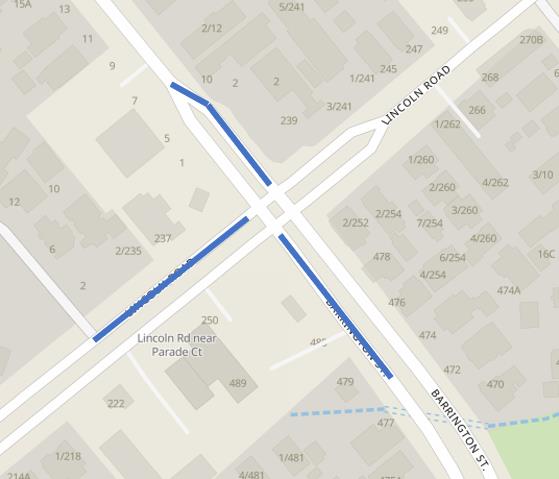link to page 1 link to page 1 link to page 1


Traffic Operations | May 2023
Lincoln Whiteleigh Barrington Intersection
Project scope
The Lincoln/Barrington/Whiteleigh
(Figure 1) intersection was treated with a primary safe system intervention
to reduce death and serious injury crashes at the intersection. The Raised Safety Platform (RSP) is a primary
safe system intervention, which manages the speeds of vehicles travel ing through an intersection. Only the
three approaches shown in
(Figure 1) have been investigated due to 50 km/h speed limit. Lincoln Road to the
north is posted at 30 km/h.
Figure 1: Blue lines showing the approaches investigated
Using TomTom Traffic statistics, the 85th percentile operating speeds on the approaches of the intersection
were compared from before (Feb 2022) and after (Feb 2023) the RSP construction.
Findings
The investigation concluded that on the approaches to the Lincoln/Barrington/Whiteleigh intersection there
was a reduction in speeds of 5-13 km/h (13-30% reduction in speed) with the instal ation of the RSP
(Figure 2).
The mean speed on the approaches has reduced to between 3-9 km/h.
The tolerable limit (survivable speed) for pedestrians and cyclists is 30 km/h. The installation of the RSP has
reduced the speeds closer to that limit. The depature speeds of the intersection have also decreased with the
RSP installation.
34
Barrington
39
31
Whiteleigh
44
34
Lincoln Road East bound
46
20
25
30
35
40
45
50
2023 (with RSP)
2022
Figure 2: Approach 85th percentile operating speeds
Lincoln/Barrington/Whiteleigh – 6 month review |

Traffic Operations | May 2023
Assumptions
As part of using TomTom data, the following assumptions have been noted:
• Approach gradients are not considered.
• TomTom data only provides mean, median, 15th, 50th and 85th speeds. 85th speeds have been used as all
values are not free flow speeds.
• TomTom data is only a sample of vehicles through the intersection, but it is considered that it is a
reasonable representative sample.
• Speed limit changes on Lincoln Road have impacted user’s habits through this corridor.
Crash records (CAS)
Crash data has been extracted from the Crash Analysis System for a full five year period to 2022, and 2023.
There have been no recorded crashes at the intersection so far this annual year1.
Severity/Year
2018
2019
2020
2021
2022
2023
Serious
1
0
0
1
0
Minor
0
2
0
0
2
Non-injury
3
5
2
4
0
There was one crash late in 2022 post implementation of the platform, when a car hit the rear end of a vehicle
when slowing for the signals on the Lincoln Road apporach from Addington Village. The driver of the vehicle
was trying to prevent an item from leaving the dashboard and failed to see the car in front.
Recommendations
From this initial 6 month review, the following recommendations could be made:
• VicRoads provides guidance of 1:15 grade for all approaches with 100 mm of height to provide a
comfortable max speed of 30 km/h for motor vehicles. Prioritizing these grades at locations with high
numbers of active transport users is required.
• It is recommended that the approach gradients at Lincoln/Barrington/Whiteleigh are investigated to
determine if speed reductions correlate.
• Create a vertical deflection infrastructure design standard within Christchurch City Council for
intersections and crossings where there is exposure to people walking, cycling and scooting.
• Waka Kotahi found retrofitted raised safety platforms are more expensive and difficult to get right than
new builds, so while new intersection works are being completed, they should be installed.
• Continue to deliver primary safe system treatments throughout the city which help provide speeds where
mistakes will not result in vulnerable road user deaths or serious injuries.
• Prioritize safe system aligned interventions to continue the Road to Zero Vision, where no one is killed or
seriously injured in road crashes.
Notes:
As part of the safe system approach the target safe operating speed for motor vehicles on streets with
vulnerable users (pedestrians and cyclists) is 30km/h. They assist in decreasing motor vehicle speeds to
30 km/h, which is the tolerable limit for pedestrians and cyclists. The likelihood of death for a vulnerable user at
30 km/h is roughly 10%, at 40 km/h it rises to 40% and at the posted speed of 50 km/h it is rises again to 80%.
This means that RSP’s decrease the likelihood of deaths and serious injuries to pedestrians and cyclists.
1It is understood that it is currently taking 2 weeks for the reporting of a serious crash and up to 30 days for a minor crash.
Lincoln/Barrington/Whiteleigh – 6 month review |


